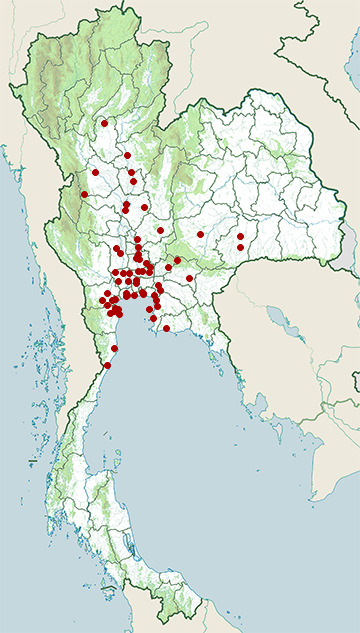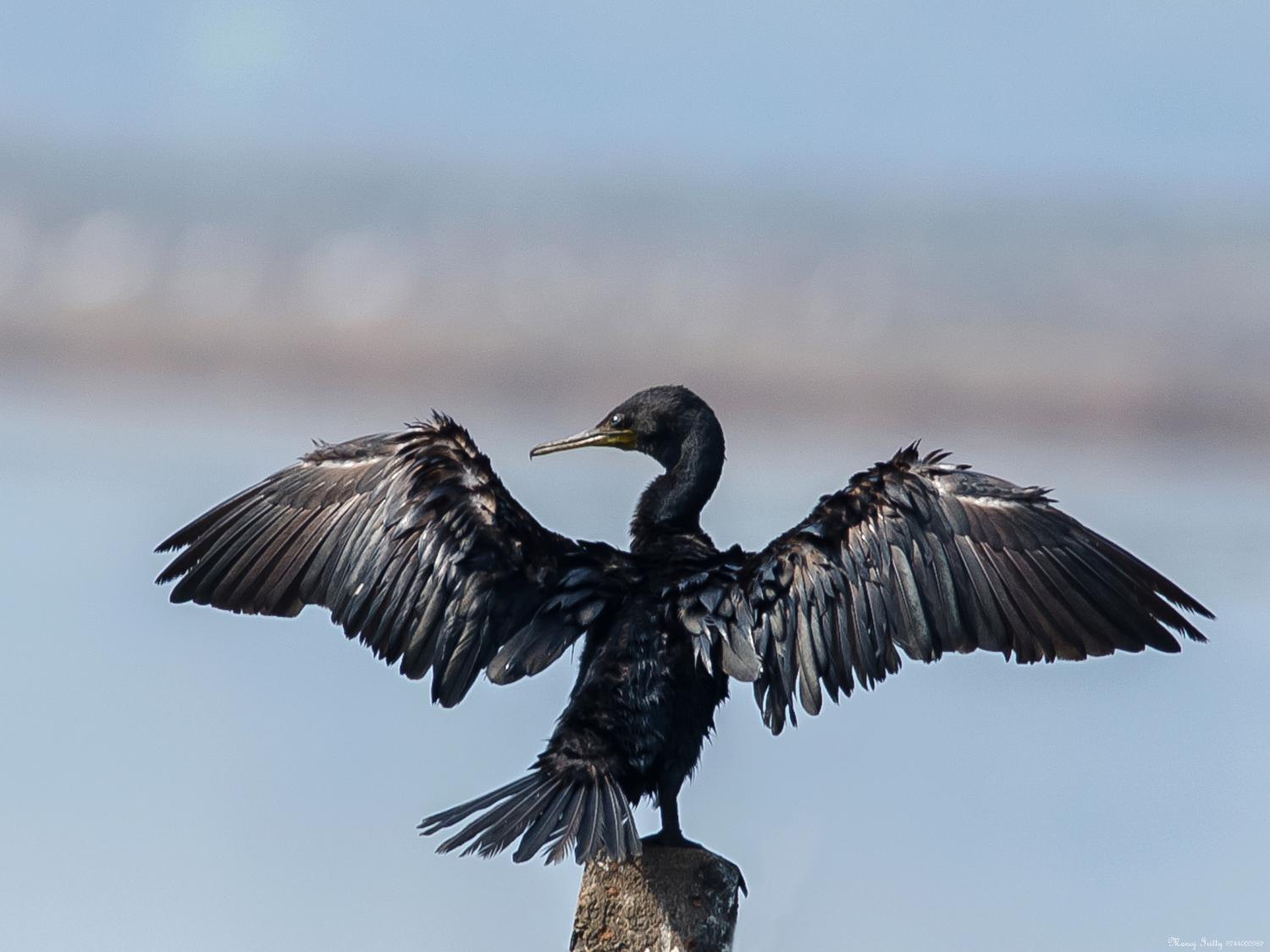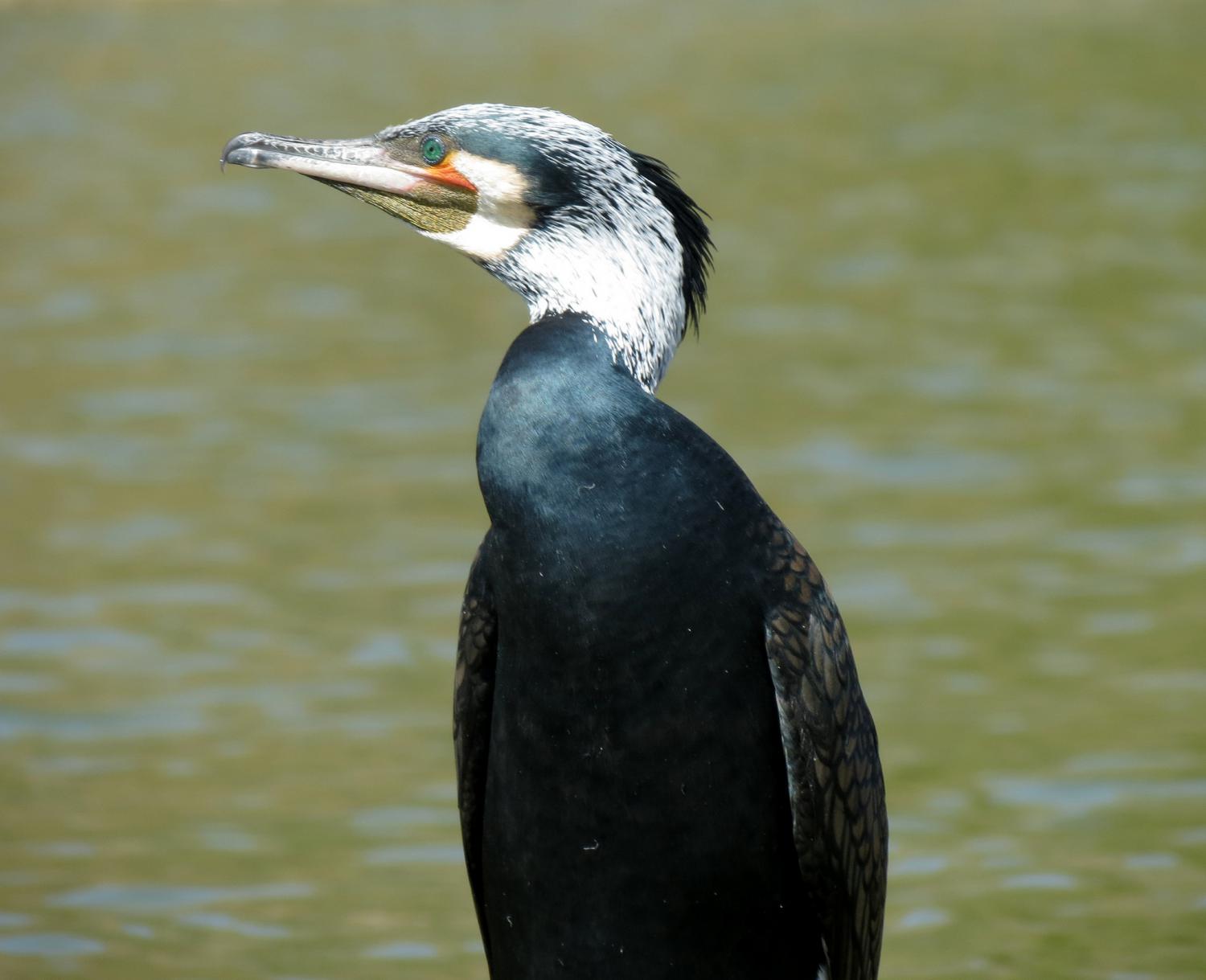Species of Thailand
Indian cormorant
Phalacrocorax fuscicollis
James Francis Stephens, 1826
In Thai: นกกาน้ำปากยาว
The Indian cormorant or Indian shag (Phalacrocorax fuscicollis) is a member of the cormorant family. It is found mainly along the inland waters of the Indian Subcontinent but extending west to Sind and east to Thailand and Cambodia. It is a gregarious species that can be easily distinguished from the similar sized little cormorant by its blue eye, small head with a sloping forehead and a long narrow bill ending in a hooked tip.
Description
This medium-sized bronze brown cormorant is scalloped in black on the upper plumage, lacks a crest and has a small and slightly peaked head with a long narrow bill that ends in a hooked tip. The eye is blue and bare yellow facial skin during the non-breeding season. Breeding birds have a short white ear tuft. In some plumages it has a white throat but the white is restricted below the gape unlike in the much larger great cormorant. Sexes are similar, but non-breeding adults and juveniles are browner.
Habitat and distribution
This cormorant fishes gregariously in inland rivers or large wetlands of peninsular India and northern part of Sri Lanka. It also occurs in estuaries and mangroves but not on the open coast. They breed very locally in mixed species breeding colonies. They extend north-east to Assam and eastward into Thailand, Burma and Cambodia.
Behaviour
The breeding season is July to February but depends on rainfall and water conditions. In northern India, they breed from July to February and in Sri Lanka, between November and February. The nest is a platform of twigs placed in the forks of partially submerged trees or those growing on islands. The nests are placed in close proximity to those of other Indian cormorants, storks or waterbirds in dense colonies, often with several tiers of nests. The usual clutch is three to five eggs which are bluish green and with a chalky surface.
The Indian cormorant makes short dives to capture fish and a group will often fish communally, forming a broad front to drive fish into a corner.
This article uses material from Wikipedia released under the Creative Commons Attribution-Share-Alike Licence 3.0. Eventual photos shown in this page may or may not be from Wikipedia, please see the license details for photos in photo by-lines.
Category / Seasonal Status
Wiki listed status (concerning Thai population): Rare winter visitor, formerly bred
BCST Category: Recorded in an apparently wild state within the last 50 years
BCST Seasonal status: Resident or presumed resident
Scientific classification
- Kingdom
- Animalia
- Phylum
- Chordata
- Class
- Aves
- Order
- Suliformes
- Family
- Phalacrocoracidae
- Genus
- Phalacrocorax
- Species
- Phalacrocorax fuscicollis
Common names
- Thai: นกกาน้ำปากยาว
Photos
Please help us review the bird photos if wrong ones are used. We can be reached via our contact us page.
Range Map

- Amphawa District, Samut Songkhram
- Ban Laem District, Phetchaburi
- Ban Lat District, Phetchaburi
- Ban Pho District, Chachoengsao
- Ban Phraek District, Phra Nakhon Si Ayutthaya
- Bang Ban District, Phra Nakhon Si Ayutthaya
- Bang Lamung District, Chonburi
- Bang Len District, Nakhon Pathom
- Bang Pahan District, Phra Nakhon Si Ayutthaya
- Bang Pakong District, Chachoengsao
- Bang Phra Non-Hunting Area
- Bang Pu Recreation Centre
- Bangkok Province
- Bangkok Coast
- Bueng Boraped Non-Hunting Area
- Bueng Boraphet Non-Hunting Area
- Don Chedi District, Suphan Buri
- Huai Chorakhe Mak Reservoir Non-Hunting Area
- Kabin Buri District, Prachinburi
- Kamphaeng Saen District, Nakhon Pathom
- Khao Sam Roi Yot National Park
- Khao Yai National Park
- Khao Yoi District, Phetchaburi
- Khlong Luang District, Pathum Thani
- Ko Sichang District, Chonburi
- Laem Pak Bia
- Mae Wong National Park
- Mahachai Mangrove Forest Learning & Development Center
- Mueang Chachoengsao District, Chachoengsao
- Mueang Chonburi District, Chonburi
- Mueang Kamphaeng Phet District, Kamphaeng Phet
- Mueang Nakhon Pathom District, Nakhon Pathom
- Mueang Nakhon Ratchasima District, Nakhon Ratchasima
- Mueang Nonthaburi District, Nonthaburi
- Mueang Phetchaburi District, Phetchaburi
- Mueang Phichit District, Phichit
- Mueang Phitsanulok District, Phitsanulok
- Mueang Prachuap Khiri Khan District, Prachuap Khiri Khan
- Mueang Ratchaburi District, Ratchaburi
- Mueang Rayong District, Rayong
- Mueang Samut Prakan District, Samut Prakan
- Mueang Samut Sakhon District, Samut Sakhon
- Mueang Samut Songkhram District, Samut Songkhram
- Mueang Suphanburi District, Suphan Buri
- Nong Suea District, Pathum Thani
- Pa Sak Chonlasit Dam Non-Hunting Area
- Pak Phli District, Nakhon Nayok
- Pak Thale
- Pak Tho District, Ratchaburi
- Phaisali District, Nakhon Sawan
- Phayuha Khiri District, Nakhon Sawan
- Phra Nakhon Si Ayutthaya District, Phra Nakhon Si Ayutthaya
- Phutthamonthon District, Nakhon Pathom
- Sai Noi District, Nonthaburi
- Samut Prakan Province
- Samut Sakhon Coast
- Sanam Bin Reservoir Non-Hunting Area
- Si Satchanalai District, Sukhothai
- Taphan Hin District, Phichit
- Tha Wung District, Lopburi
- Thanyaburi District, Pathum Thani
- Wang Noi District, Phra Nakhon Si Ayutthaya
- Wat Phai Lom & Wat Ampu Wararam Non-Hunting Area



